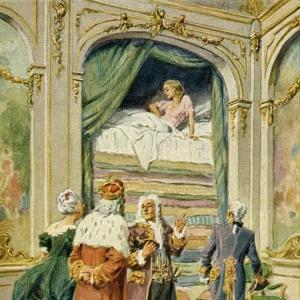Reading time: 9 min
There was once a darning-needle who thought herself so fine that she fancied she must be fit for embroidery. „Hold me tight,“ she would say to the fingers, when they took her up, „don’t let me fall. If you do I shall never be found again, I am so very fine.“
„That is your opinion, is it?“ said the fingers, as they seized her round the body.
„See, I am coming with a train,“ said the darning-needle, drawing a long thread after her; but there was no knot in the thread.
The fingers then placed the point of the needle against the cook’s slipper. There was a crack in the upper leather, which had to be sewn together.
„What coarse work!“ said the darning-needle, „I shall never get through. I shall break!– I am breaking!“ and sure enough she broke. „Did I not say so?“ said the darning-needle, „I know I am too fine for such work as that.“
„This needle is quite useless for sewing now,“ said the fingers; but they still held it fast, and the cook dropped some sealing-wax on the needle, and fastened her handkerchief with it in front.
„So now I am a breast-pin,“ said the darning-needle; „I knew very well I should come to honor some day: merit is sure to rise;“ and she laughed, quietly to herself, for of course no one ever saw a darning-needle laugh. And there she sat as proudly as if she were in a state coach, and looked all around her. „May I be allowed to ask if you are made of gold?“ she inquired of her neighbor, a pin; „you have a very pretty appearance, and a curious head, although you are rather small. You must take pains to grow, for it is not every one who has sealing-wax dropped upon him;“ and as she spoke, the darning-needle drew herself up so proudly that she fell out of the handkerchief right into the sink, which the cook was cleaning. „Now I am going on a journey,“ said the needle, as she floated away with the dirty water, „I do hope I shall not be lost.“ But she really was lost in a gutter. „I am too fine for this world,“ said the darning-needle, as she lay in the gutter. „But I know who I am, and that is always some comfort.“ So the darning-needle kept up her proud behavior, and did not lose her good humor. Then there floated over her all sorts of things,– chips and straws, and pieces of old newspaper. „See how they sail,“ said the darning-needle; „they do not know what is under them. I am here, and here I shall stick. See, there goes a chip, thinking of nothing in the world but himself– only a chip. There’s a straw going by now; how he turns and twists about! Don’t be thinking too much of yourself, or you may chance to run against a stone. There swims a piece of newspaper. What is written upon it has been forgotten long ago, and yet it gives itself airs. I sit here patiently and quietly. I know who I am, so I shall not move.“
One day something lying close to the darning-needle glittered so splendidly that she thought it was a diamond. Yet it was only a piece of broken bottle. The darning-needle spoke to it, because it sparkled, and represented herself as a breast-pin. „I suppose you are really a diamond?“ she said.
„Why yes, something of the kind,“ he replied; and so each believed the other to be very valuable, and then they began to talk about the world, and the conceited people in it.
„I have been in a lady’s work-box,“ said the darning-needle, „and this lady was the cook. She had on each hand five fingers, and anything so conceited as these five fingers I have never seen; and yet they were only employed to take me out of the box and to put me back again.“
„Were they not high-born?“
„High-born!“ said the darning-needle, „no indeed, but so haughty. They were five brothers, all born fingers. They kept very proudly together, though they were of different lengths. The one who stood first in the rank was named the thumb, he was short and thick, and had only one joint in his back, and could therefore make but one bow; but he said that if he were cut off from a man’s hand, that man would be unfit for a soldier. Sweet-tooth, his neighbor, dipped himself into sweet or sour, pointed to the sun and moon, and formed the letters when the fingers wrote. Longman, the middle finger, looked over the heads of all the others. Gold-band, the next finger, wore a golden circle round his waist. And little Playman did nothing at all, and seemed proud of it. They were boasters, and boasters they will remain; and therefore I left them.“
„And now we sit here and glitter,“ said the piece of broken bottle.
At the same moment more water streamed into the gutter, so that it overflowed, and the piece of bottle was carried away.
„So he is promoted,“ said the darning-needle, „while I remain here. I am too fine, but that is my pride, and what do I care?“ And so she sat there in her pride, and had many such thoughts as these,– „I could almost fancy that I came from a sunbeam, I am so fine. It seems as if the sunbeams were always looking for me under the water. Ah! I am so fine that even my mother cannot find me. Had I still my old eye, which was broken off, I believe I should weep; but no, I would not do that, it is not genteel to cry.“
One day a couple of street boys were paddling in the gutter, for they sometimes found old nails, farthings, and other treasures. It was dirty work, but they took great pleasure in it. „Hallo!“ cried one, as he pricked himself with the darning-needle, „here’s a fellow for you.“
„I am not a fellow, I am a young lady,“ said the darning-needle; but no one heard her.
The sealing-wax had come off, and she was quite black; but black makes a person look slender, so she thought herself even finer than before.
„Here comes an egg-shell sailing along,“ said one of the boys. So they stuck the darning-needle into the egg-shell.
„White walls, and I am black myself,“ said the darning-needle, „that looks well. Now I can be seen, but I hope I shall not be sea-sick, or I shall break again.“ She was not sea-sick, and she did not break. „It is a good thing against sea-sickness to have a steel stomach, and not to forget one’s own importance. Now my sea-sickness has past: delicate people can bear a great deal.“
Crack went the egg-shell, as a waggon passed over it. „Good heavens, how it crushes!“ said the darning-needle. „I shall be sick now. I am breaking!“ but she did not break, though the waggon went over her as she lay at full length; and there let her lie.
 Learn languages. Double-tap on a word.Learn languages in context with Childstories.org and Deepl.com.
Learn languages. Double-tap on a word.Learn languages in context with Childstories.org and Deepl.com.Backgrounds
Interpretations
Adaptions
Summary
Linguistics
„The Darning-Needle“ is a short fairy tale written by Danish author Hans Christian Andersen, first published in 1845. Andersen is best known for his collection of fairy tales, which includes classics such as „The Little Mermaid,“ „The Ugly Duckling,“ „The Emperor’s New Clothes,“ and „The Snow Queen.“ His stories often contain moral messages and are appreciated by both children and adults.
Hans Christian Andersen was born in Odense, Denmark, in 1805. He grew up in poverty and had a difficult childhood, but his vivid imagination and love for storytelling provided an escape from his challenging circumstances. Andersen moved to Copenhagen at the age of 14 to pursue a career in the performing arts but eventually shifted his focus to writing. He published his first book of fairy tales in 1835 and continued to write until his death in 1875.
Andersen’s fairy tales have been translated into over 150 languages and continue to be beloved by readers of all ages. Many of his stories have been adapted into various forms of media, such as films, plays, and musicals. His unique storytelling style, which often combines elements of fantasy, realism, and a strong moral underpinning, has left a lasting impact on the world of literature and popular culture.
„The Darning-Needle“ can be interpreted on multiple levels, reflecting various themes and messages:
Pride and self-importance: The darning-needle is a character who is excessively proud and self-important. Her belief in her own superiority leads her to view herself as too delicate for the tasks she was designed for. This pride and self-importance serve as a cautionary tale against arrogance and an inflated sense of one’s own value.
The illusion of grandeur: The darning-needle continually insists that she is made for grander things, despite her humble origins and purpose. Her conversations with the piece of broken bottle, which she mistakes for a diamond, emphasize the idea that people often attribute more value and importance to themselves and others based on superficial appearances.
The folly of vanity: The darning-needle’s vanity leads her to a series of misadventures, including falling into a sink, lying in a gutter, and being stuck into an eggshell. This demonstrates the foolishness of placing too much importance on one’s own appearance or status.
Resilience: Despite the many challenges the darning-needle faces, she remains unbroken, even after being run over by a wagon. This can be interpreted as a metaphor for the resilience of the human spirit, or the idea that people can endure and persevere in the face of adversity.
Critique of social hierarchy and class: The darning-needle’s interactions with the various objects and characters in the story highlight the arbitrary nature of social hierarchies and the pretensions of those who consider themselves superior. The needle’s disdain for the cook’s fingers, for example, showcases the foolishness of looking down on others based on superficial distinctions.
„The Darning Needle“ by Hans Christian Andersen has been adapted and retold in various forms over the years, including:
Children’s Books: The story has been adapted into numerous children’s books with various illustrations and retellings. Some notable examples include „The Darning Needle“ illustrated by Vladyslav Yerko and „The Brave Little Darning Needle“ by Usborne.
Animated Shorts: The story has also been adapted into animated shorts and television shows. For example, the Japanese anime series „Grimm’s Fairy Tale Classics“ features an episode based on the story.
Plays and Musicals: The story has been adapted into stage plays and musicals. For example, the Danish Royal Theater produced a play based on the story in 2012.
Films: The story has been adapted into several short films and independent productions. For example, the 2005 short film „The Darning Needle“ by director Ian Woodward won several awards at film festivals.
Art and Literature: The story has also inspired works of art and literature, including paintings, sculptures, and poems. For example, the American poet Robert Frost wrote a poem called „The Witch of Coös“ which was inspired by „The Darning Needle.“
Overall, „The Darning Needle“ has proven to be a popular and enduring fairy tale that has inspired numerous adaptations across different mediums.
„The Darning-Needle“ by Hans Christian Andersen is a fairy tale about a conceited darning-needle who believes herself too fine for ordinary work. When the needle breaks while sewing a cook’s slipper, she is transformed into a makeshift breast-pin using sealing-wax. The needle becomes prideful and believes she is of great importance.
One day, she falls into the sink, and as she floats away with the dirty water, she considers herself too fine for this world. While lying in the gutter, she encounters a piece of broken bottle that she believes to be a diamond, and they both commiserate about the conceited people in the world. The piece of broken bottle is eventually washed away, leaving the darning-needle behind, still filled with pride.
Later, a couple of street boys find the needle, now black due to the sealing-wax coming off, and stick her into an eggshell. The needle is relieved that she doesn’t get seasick and feels she has endured a lot. However, her journey ends when a wagon runs over the eggshell, but she remains unbroken and continues to lay there, full of her own self-importance.
Linguistic analysis of Hans Christian Andersen’s „The Darning-Needle“ reveals a rich tapestry of language use that characterizes the story’s themes, structures, and the author’s unique style.
Personification and Anthropomorphism: The primary linguistic feature in this fairy tale is the personification of the darning-needle. Andersen assigns human attributes to an inanimate object, allowing the needle to express pride, vanity, and self-awareness. Sentences like „I am too fine for such work as that“ highlight the needle’s self-perceived superiority. This anthropomorphism extends to other objects such as the piece of broken bottle and the fingers, each imbued with their personality and perspective, contributing to the moral and thematic depth of the story.
Dialogue: The use of dialogue between the needle and other objects or characters (like the fingers and the pin) serves to reveal character traits and the needle’s pretentious nature. The dialogue is often marked by irony as the needle’s exaggerated self-importance contrasts with its true ludicrous situation. The conversational exchanges are simple but carry underlying critiques of pride and self-importance.
Irony and Satire: Andersen employs irony throughout the narrative. The darning-needle’s pride is consistently undercut by the reality of its situations—boasting of becoming a „breast-pin“ while being stuck with sealing-wax, and lamenting its perceived grandeur amidst dirty water in a gutter. The needle’s claims and reality diverge, providing a satirical look at human tendencies toward vanity and self-delusion.
Imagery and Symbolism: Visual imagery is prominent, juxtaposing images of grandeur with those of a mundane or degrading nature. The needle imagines itself as a part of a majestic sunbeam or a valuable object like a diamond, when in fact it is just a needle lying amongst debris. Symbolically, the needle can be interpreted as representing individuals who fail to see their true position, illustrating themes of pride before a fall.
Narrative Style: The narrative voice is observational and slightly detached, providing readers with a subtle critique of the needle. Andersen’s style here is simple and straightforward, typical of fairy tales, yet laced with layers that offer commentary on social behaviors. The progression of the narrative follows the classic fairy-tale structure of rise and fall, where the needle’s journey from perceived importance to abandonment in a gutter conveys moral lessons.
Lexical Choices: Vocabulary in the story is accessible, allowing readers of varied ages to grasp the narrative. Despite the simplicity, word choices related to vanity, value, and perception, like „fine,“ „honor,“ „diamond,“ and „sunbeam,“ enhance the thematic elements. The shifting terms used to describe the needle—darning-needle, breast-pin, young lady—reflect its changing self-identity and serve as a mechanism to critique its persistent vanity.
In summary, „The Darning-Needle“ uses linguistic features to weave a tale rich in irony, personification, and moral insight. Andersen’s manipulation of language allows objects to echo human follies, creating a narrative that is both entertaining and thought-provoking.
Information for scientific analysis
Fairy tale statistics | Value |
|---|---|
| Translations | DE, EN, DA, ES, FR, IT, NL |
| Readability Index by Björnsson | 26.8 |
| Flesch-Reading-Ease Index | 85.5 |
| Flesch–Kincaid Grade-Level | 5 |
| Gunning Fog Index | 7.3 |
| Coleman–Liau Index | 7.3 |
| SMOG Index | 7.3 |
| Automated Readability Index | 4.5 |
| Character Count | 6.421 |
| Letter Count | 4.832 |
| Sentence Count | 83 |
| Word Count | 1.232 |
| Average Words per Sentence | 14,84 |
| Words with more than 6 letters | 147 |
| Percentage of long words | 11.9% |
| Number of Syllables | 1.548 |
| Average Syllables per Word | 1,26 |
| Words with three Syllables | 42 |
| Percentage Words with three Syllables | 3.4% |

 Facebook
Facebook  Whatsapp
Whatsapp  Messenger
Messenger  Telegram
Telegram Reddit
Reddit















